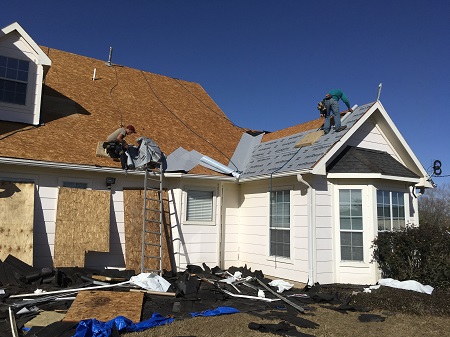In the first post on my Breaking Down The Roof series, I covered the steps prior to roof removal, and the second covered the actual process of tearing off the shingles. Today, I will discuss the underlayment, and why it’s necessary.
What Is The Roofing Underlayment?
The next step in building your roof is critical. You need a quality underlayment installed to protect the roof deck. There are a few reasons to use an underlayment.
The first is to temporarily dry in a roof. Once we have all the shingles torn off of a roof slope, we can install the underlayment to prevent water from a surprise thunderstorm from causing interior damage. There are many times, especially in Southeast Texas, that a 10% chance of rain turns into 100% chance in just a couple hours’ time. In order to maintain our schedule, and be as efficient as possible, we usually will go ahead and start work if there is up to a 40% chance of rain. Of course, that decision is project, and weather, specific.
Another reason why underlayment is critical is that it makes the roof safer to walk on. 15# felt is more likely to tear, so I insist on installing 30# felt as my absolute minimum.
Perhaps the most important reason to invest in a high quality deck protection is moisture. A good underlayment helps moisture from being trapped in the roofing system, which will begin to rot your roof deck from the top side down.
Another added benefit of underlayments are that they help aid in the replacement of the roof in the future, preventing shingles from sticking directly to the roof deck, which may require sections to be replacement.
Lastly, a relatively unknown benefit to having a underlayment installed is it allows for most shingles to increase their fire rating to a UL Class A rating.
What Underlayment Options Are There?
Each of the major shingle manufacturers has their own product lines of underlayments. These are meant to work in conjunction with the entire roofing system to protect your roof for the long-term. In fact, all quality shingle manufacturers require underlayment in order to warrant their product.
Asphalt organic based 15# & 30# felts are outdated, but still available. The pricing difference between these and synthetics is almost negligible, so I rarely recommend either one.
GAF ShingleMate is good roof deck protectant that is an upgrade over the organic felts. It is a fiberglass reinforced underlayment, and helps to lay flatter than the organic felts.
Since I first wrote this article, synthetic underlayments have been much more common. For a re-roof application, the GAF FeltBuster is a great option, as is the Certainteed RoofRunner. For new construction builds, I tend to recommend the GAF TigerPaw because it can be left exposed for up to 180 days.

Which Underlayment Is Best?
One of the common questions I get is which underlayment is best. While 15# felt is acceptable for general water tightness, the minimum that a reputable contractor will is install is 30# felt.
I recommend GAF’s FeltBuster and Certainteed’s RoofRunner because they are stronger products, and specifically manufactured to be installed as part of a complete roofing system.
Another product that is available is the Low-E ThermaSheet, which allows for a reduction in the heat transferred into the attic through the shingles and roof deck. I will be covering ThermaSheet more in depth when I discuss energy efficiency.
Next time, I will cover various flashings, their purposes, and their issues.
Until next time,
Travis Diekmann
The Texan Roofer

